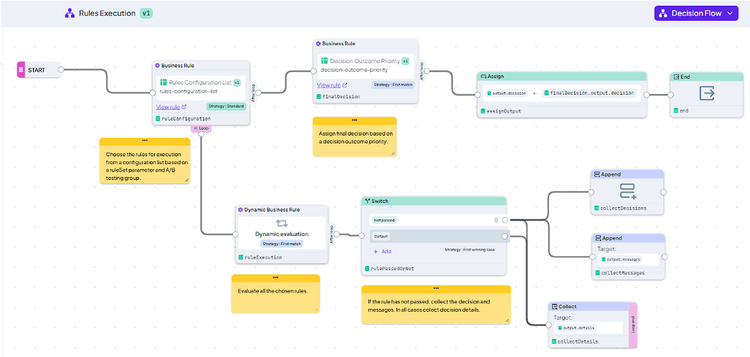For risk managers, relying on rigid, hard-coded decision processes can often limit operational agility. The ability to dynamically combine and execute rule sets without waiting for code deployments is essential for saving time and maintaining portfolio quality. DecisionRules makes this possible by offering versatile no-code patterns that centralize the definition and execution of complex rule sets for credit decisioning.
Why Hard-Coded Logic Blocks Your Credit Strategy
Traditionally, hard coded rules have been a nightmare for companies which need to flexibly adapt their credit decisioning strategies to changing market conditions in order to keep the quality of the portfolio as well as the volumes on a high level.
Just as with inflexible scoring models, the traditional process for changing hard-coded eligibility rules involves a frustrating, multi-week cycle of specifications, IT development, and testing.
Typical change process to the hard coded rules (not only introducing a new rule but also using existing rule for a new product, or just changing its parameters) took the following steps:
- Specification: specification of a required change by Risk Analyst or Product Owner
- Resources Assignment: assignment of IT resources, usually subject to prioritization
- Development: change of hard-coded rules by IT people
- Testing: testing of the change by IT testers
- Acceptance Testing: acceptance testing by Risk Analyst or Product Owner
- Launch: launch to production
Such a process typically takes at least several weeks which is a “speed” that does not provide the flexibility necessary to control the credit risks of the portfolio at all.
How to Achieve Agile Rule Management Without Coding
Reusable Rule Set Templates
DecisionRules solves this by placing rule management directly into the hands of Risk and Product teams. Similar to how our scorecard patterns provide structure and flexibility, these Rule Set templates for eligibility and policy offer a governed, no-code approach.
Let’s explore how these patterns, available directly in the DecisionRules Template library, transform rule management from a bottleneck into a strategic advantage.
Simple Start: Parallel Rule Calling or Rule Configuration List
The Parallel Rule Calling mechanism uses a simple visual flow where individual rules are called in parallel, and their results are collected at the end. This template is ideal for smaller, less complex rule sets.

Parallel Rule calling template
The Rule Configuration List mechanism offers more dynamic control. Instead of being static, the list of rules to be executed is defined in a Decision Table. This allows you to use conditions to determine which rules run dynamically.

Rule Configuration List template - the Decision Flow

Rule Configuration List template - the definition Decision Table
Advanced Credit Decisioning: Eligibility and Policy Rules Pattern
The most advanced solution, the Eligibility and Policy Rules pattern, represents the ultimate cure. It fully decouples the "what" (the list of rules to run) from the "how" (the execution logic). This dynamic approach allows you to run completely different Rule Sets (like "Eligibility" or "Policy") using the same underlying Decision Flow, reliably arriving at a single, prioritized outcome.

Eligibility and Policy Rules template overview
Implementing the Eligibility and Policy Rules Pattern: A Step-by-Step Guide
How the Pattern Works: A Clear Separation of Concerns
At its core, the Eligibility and Policy Rules pattern simplifies complex decisioning by separating key components:
- Rule Library where all individual rules are defined, regardless of their purpose
- Decision Outcomes definition and prioritization
- Rule Sets Definition (assignment of specified rules to trigger a specific outcome)
- Rule Sets Execution
Let’s go through this concept step by step.
Rule Library
The foundation of this pattern is a centralized, reusable library of every individual business rule. Rule Library is a set of individual Rules, each represented by one of the rule types that DecisionRules offer, with a standardized output model.
Typically, Decision Tables or Decision Trees will be used for the individual Rules, but other types of rules including Decision Flows can be used as well.
Each Rule includes:
- Input data model listing the variables necessary to evaluate the Rule
- Output data model containing the Rule ID, a passed flag and a message which is triggered when the Rule is not passed
- Sets of conditions (typically columns and rows in Decision Table) that define whether the Rule is passed or not
- A unique alias used for referencing the Rule in a Rule set
An example of such a Rule is can be seen below:

Example of a rule (SAL-01 Low Salary)
In your Rule Library, you can have all your Rules regardless of their outcome. They can be all placed in one folder (such as the folder Rule Definition in our template) or spread across different folders or even spaces.
Adding a new Rule is very simple - just clone the provided template XXX-YY Template, adjust it to match your need and you can instantly include it into a Rule Set.
Decision Outcomes
The second thing to define are the Decision Outcomes which specify the action that the rule is triggering. Instead of hard-coding outcomes, you define them in a simple, prioritized table, giving you full control over the final decision. Typically, the default Outcome when no Rule is triggered is “Accept”, and the Outcome of any triggered Rule is “Decline”. However, there can be other Outcomes as well, such as “Verify”, “Decide Manually”, etc.
For definition of these Outcomes and their priority, the pattern contains a table Decision Outcomes Priority which enables you to define your possible Outcomes and their priority (defined by their order in the table).

Decision Table with definition of Decision Outcomes
To add a new Outcome is again very easy - just copy any existing row, change the Outcome name and place the row to the appropriate rank in the table.
Rule Sets Definition
This is the heart of the pattern's flexibility. Here, you dynamically group rules from your library to create complete Rule Sets for different purposes (e.g., Eligibility, Policy) without duplicating logic.
Each Rule Set is defined as a list of Rules and their corresponding Outcomes, optionally conditioned based on other attributes (such as, for example, a Test Group name).
The Rule Sets are defined by a Decision Table, such as the following table Rules Configuration List used in our template.

Decision Table with definition of a Rule Set
Notes:
- Here we are defining all Rule Sets (in our case Eligibility Rules and Policy Rules) in one table, but you can split it into more tables if you wish.
- You can see that each Rule in the Rule Set is referenced by its alias - that’s why it is important that the aliases have business names. Alternatively, you can also extend this configuration by adding a rule version.
To add an existing Rule to a Rule Set, just add a row into this table, specifying Rule Set name, Rule name and alias and the Outcome.
Rule Sets Execution
Finally, the execution becomes incredibly simple. Instead of a complex, static process, you simply tell the engine which Rule Set to run. The mechanism is included in the pattern as the Rules Execution Decision Flow, so the only thing you need to do is to say which Rule Set you want to execute - do it by putting the name of the Rule Set into the input variable “ruleSet” (for example, if you want to execute Policy Rules, just put “Policy” to this variable).

Decision Flow executing the specified Rule Set
This Decision Flow takes the Rules Set name, gets the appropriate list of Rules, executes them, collects the Outcomes, Rule Ids and messages and makes the final outcome evaluation based on Outcomes priority.
The result contains the final Decision Outcome, list of messages and details of the assessed Rules for perfect auditability of the process.
You can easily plug this Decision Flow to your credit decisioning processes and get a flexible and transparent mechanism for Rules and Rule Sets definition.
Smarter Credit Logic Control
By combining flexible scorecards (as shown in our previous templates guide) with agile eligibility and policy patterns, you create a truly robust and maintainable credit decisioning engine. You eliminate coding dependencies and empower your risk team to control the entire logic—from scoring to final decision—with speed and confidence.
About the Author: Karel Svec is a Solution Consultant at DecisionRules with over 19 years of experience helping businesses manage their decisioning logic and improve efficiency. He specializes in solutions for credit decisioning, risk management and other financial use cases.

Karel Švec
Business Analyst

